Impact of Artificial Intelligence on Customer Service: A Project
VerifiedAdded on 2021/10/28
|24
|4500
|189
Project
AI Summary
This project investigates the impact of artificial intelligence (AI) in customer-oriented environments, focusing on its role in retail and customer service. The project aims to analyze the influence of AI, particularly recommender systems, on customer decision-making and to explore the future evolution of AI in customer-facing environments. The research employs a project management plan covering scope, cost, time, quality, communication, and risk. The project involves both primary and secondary data collection, including a literature review on AI's applications, recommender systems, and future trends. Data analysis includes literature review, primary data collection, and quantitative analysis. The project also discusses project management, work breakdown structure, and data collection methodologies. The project concludes with recommendations based on the findings. The project explores the impact of AI on customer experience, examining the integration of AI tools and technologies to improve user interactions in online retail and customer service industries. It covers the implications of AI in sales and CRM, manufacturing, and logistics, with an emphasis on recommender systems and their influence on customer decisions.
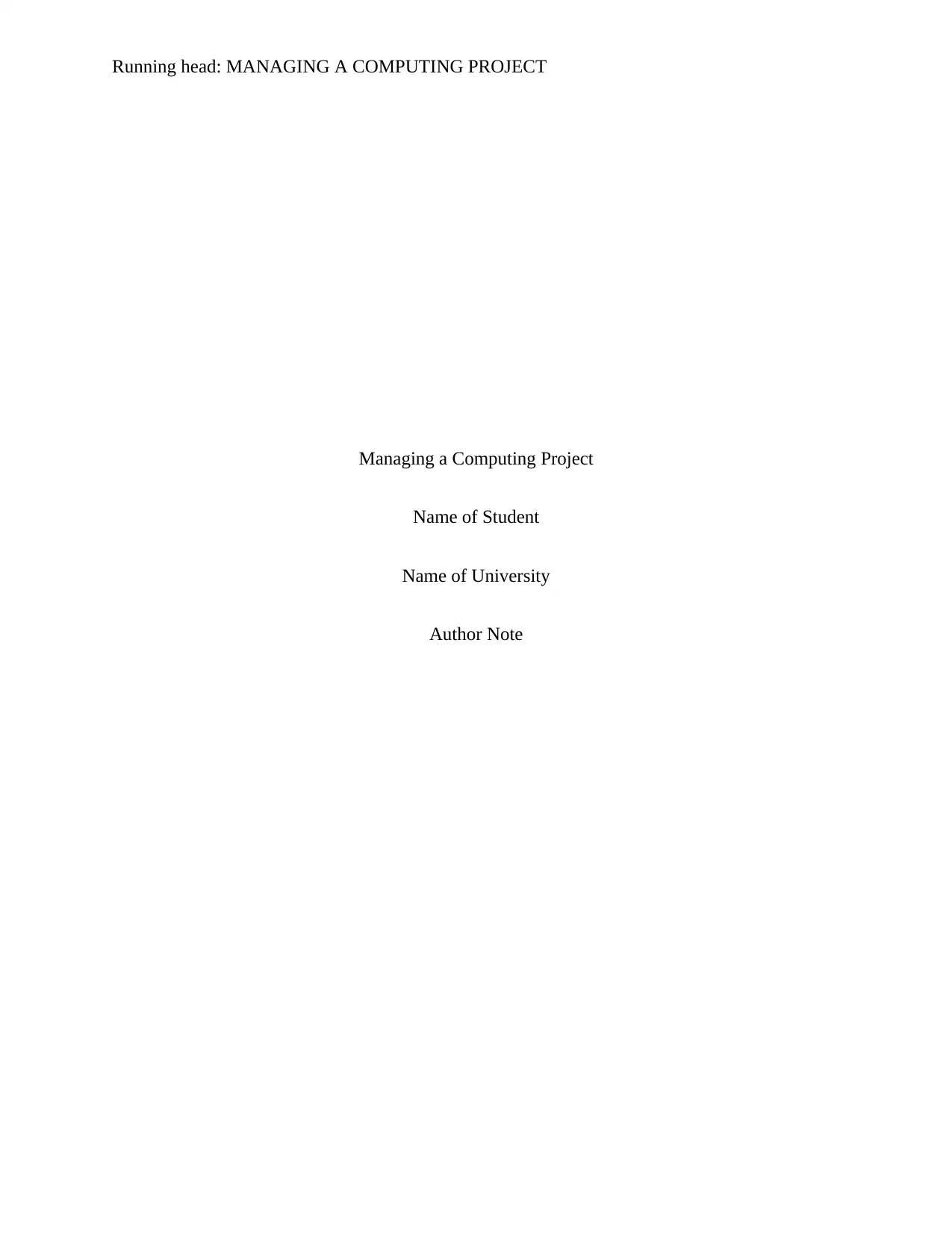
Running head: MANAGING A COMPUTING PROJECT
Managing a Computing Project
Name of Student
Name of University
Author Note
Managing a Computing Project
Name of Student
Name of University
Author Note
Paraphrase This Document
Need a fresh take? Get an instant paraphrase of this document with our AI Paraphraser
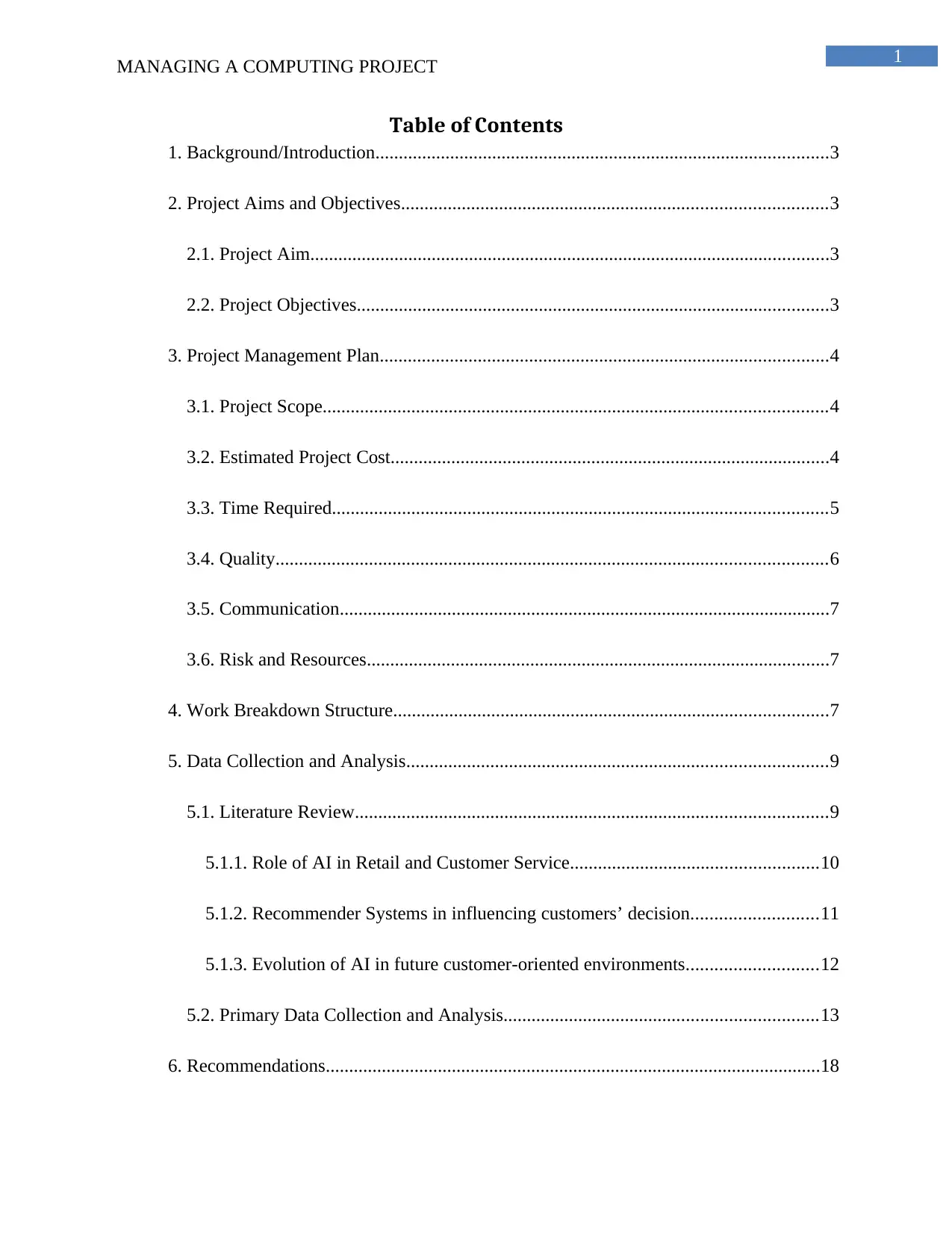
1
MANAGING A COMPUTING PROJECT
Table of Contents
1. Background/Introduction.................................................................................................3
2. Project Aims and Objectives...........................................................................................3
2.1. Project Aim...............................................................................................................3
2.2. Project Objectives.....................................................................................................3
3. Project Management Plan................................................................................................4
3.1. Project Scope............................................................................................................4
3.2. Estimated Project Cost..............................................................................................4
3.3. Time Required..........................................................................................................5
3.4. Quality......................................................................................................................6
3.5. Communication.........................................................................................................7
3.6. Risk and Resources...................................................................................................7
4. Work Breakdown Structure.............................................................................................7
5. Data Collection and Analysis..........................................................................................9
5.1. Literature Review.....................................................................................................9
5.1.1. Role of AI in Retail and Customer Service.....................................................10
5.1.2. Recommender Systems in influencing customers’ decision...........................11
5.1.3. Evolution of AI in future customer-oriented environments............................12
5.2. Primary Data Collection and Analysis...................................................................13
6. Recommendations..........................................................................................................18
MANAGING A COMPUTING PROJECT
Table of Contents
1. Background/Introduction.................................................................................................3
2. Project Aims and Objectives...........................................................................................3
2.1. Project Aim...............................................................................................................3
2.2. Project Objectives.....................................................................................................3
3. Project Management Plan................................................................................................4
3.1. Project Scope............................................................................................................4
3.2. Estimated Project Cost..............................................................................................4
3.3. Time Required..........................................................................................................5
3.4. Quality......................................................................................................................6
3.5. Communication.........................................................................................................7
3.6. Risk and Resources...................................................................................................7
4. Work Breakdown Structure.............................................................................................7
5. Data Collection and Analysis..........................................................................................9
5.1. Literature Review.....................................................................................................9
5.1.1. Role of AI in Retail and Customer Service.....................................................10
5.1.2. Recommender Systems in influencing customers’ decision...........................11
5.1.3. Evolution of AI in future customer-oriented environments............................12
5.2. Primary Data Collection and Analysis...................................................................13
6. Recommendations..........................................................................................................18

2
MANAGING A COMPUTING PROJECT
7. Reflection.......................................................................................................................19
References..........................................................................................................................21
MANAGING A COMPUTING PROJECT
7. Reflection.......................................................................................................................19
References..........................................................................................................................21
⊘ This is a preview!⊘
Do you want full access?
Subscribe today to unlock all pages.

Trusted by 1+ million students worldwide
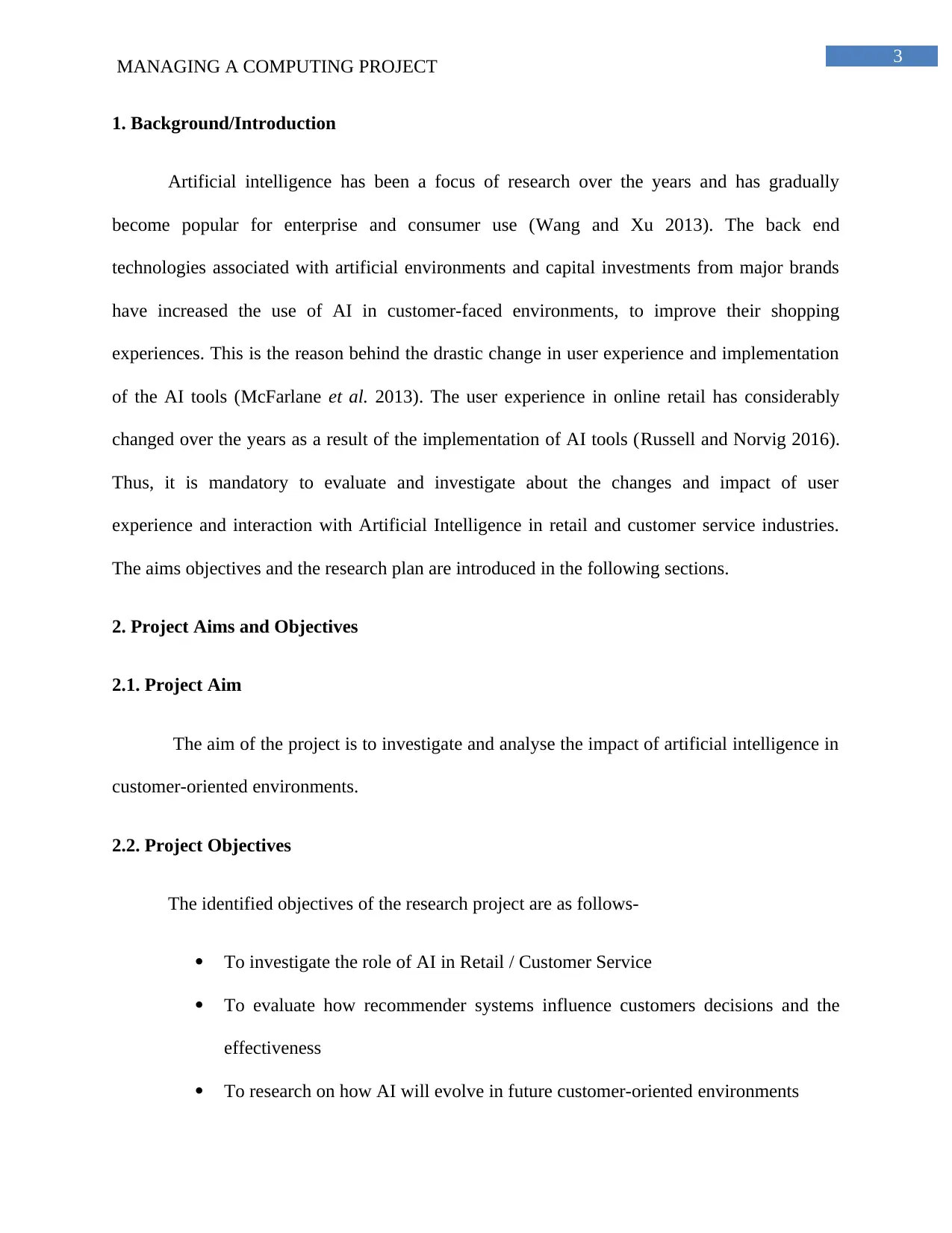
3
MANAGING A COMPUTING PROJECT
1. Background/Introduction
Artificial intelligence has been a focus of research over the years and has gradually
become popular for enterprise and consumer use (Wang and Xu 2013). The back end
technologies associated with artificial environments and capital investments from major brands
have increased the use of AI in customer-faced environments, to improve their shopping
experiences. This is the reason behind the drastic change in user experience and implementation
of the AI tools (McFarlane et al. 2013). The user experience in online retail has considerably
changed over the years as a result of the implementation of AI tools (Russell and Norvig 2016).
Thus, it is mandatory to evaluate and investigate about the changes and impact of user
experience and interaction with Artificial Intelligence in retail and customer service industries.
The aims objectives and the research plan are introduced in the following sections.
2. Project Aims and Objectives
2.1. Project Aim
The aim of the project is to investigate and analyse the impact of artificial intelligence in
customer-oriented environments.
2.2. Project Objectives
The identified objectives of the research project are as follows-
To investigate the role of AI in Retail / Customer Service
To evaluate how recommender systems influence customers decisions and the
effectiveness
To research on how AI will evolve in future customer-oriented environments
MANAGING A COMPUTING PROJECT
1. Background/Introduction
Artificial intelligence has been a focus of research over the years and has gradually
become popular for enterprise and consumer use (Wang and Xu 2013). The back end
technologies associated with artificial environments and capital investments from major brands
have increased the use of AI in customer-faced environments, to improve their shopping
experiences. This is the reason behind the drastic change in user experience and implementation
of the AI tools (McFarlane et al. 2013). The user experience in online retail has considerably
changed over the years as a result of the implementation of AI tools (Russell and Norvig 2016).
Thus, it is mandatory to evaluate and investigate about the changes and impact of user
experience and interaction with Artificial Intelligence in retail and customer service industries.
The aims objectives and the research plan are introduced in the following sections.
2. Project Aims and Objectives
2.1. Project Aim
The aim of the project is to investigate and analyse the impact of artificial intelligence in
customer-oriented environments.
2.2. Project Objectives
The identified objectives of the research project are as follows-
To investigate the role of AI in Retail / Customer Service
To evaluate how recommender systems influence customers decisions and the
effectiveness
To research on how AI will evolve in future customer-oriented environments
Paraphrase This Document
Need a fresh take? Get an instant paraphrase of this document with our AI Paraphraser
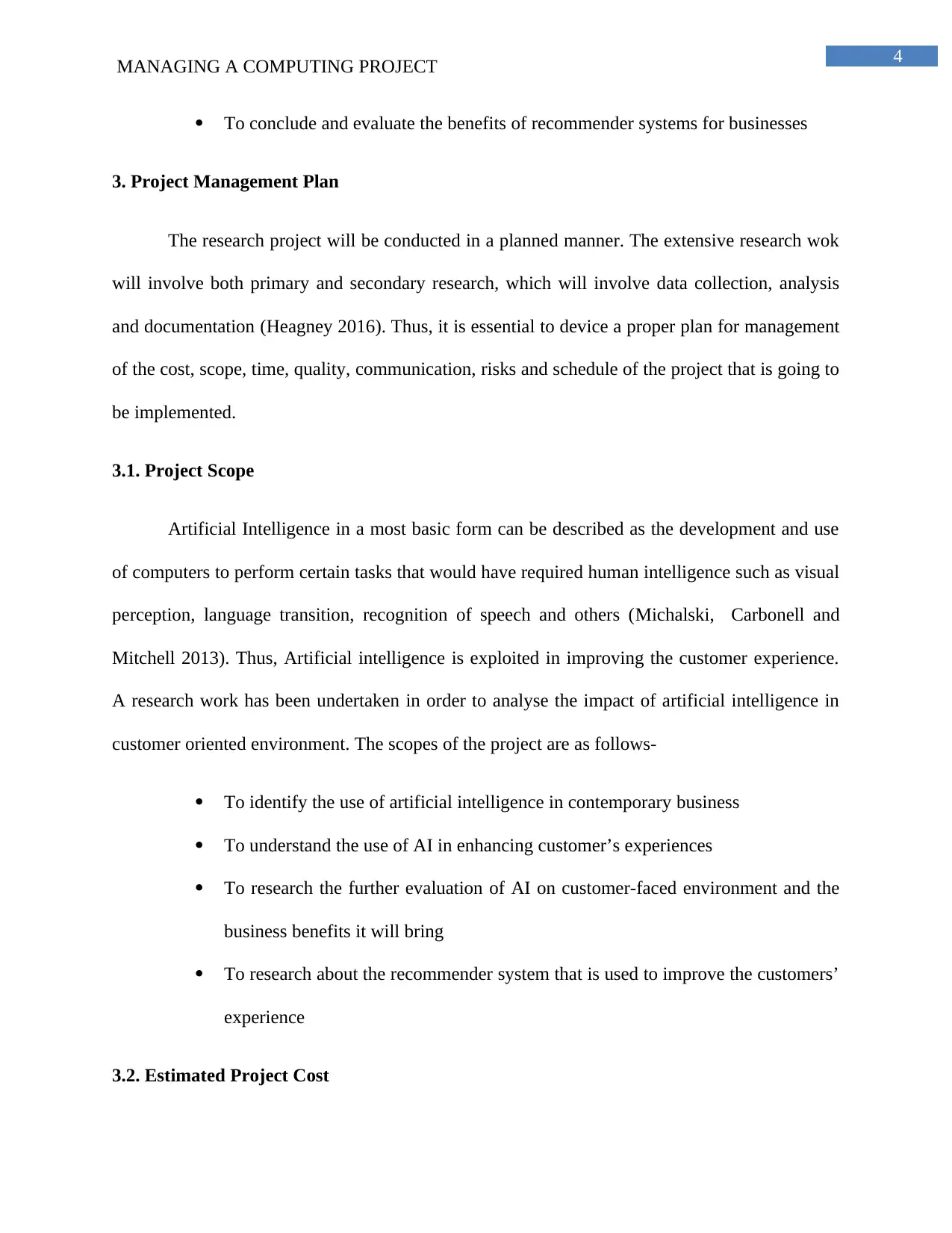
4
MANAGING A COMPUTING PROJECT
To conclude and evaluate the benefits of recommender systems for businesses
3. Project Management Plan
The research project will be conducted in a planned manner. The extensive research wok
will involve both primary and secondary research, which will involve data collection, analysis
and documentation (Heagney 2016). Thus, it is essential to device a proper plan for management
of the cost, scope, time, quality, communication, risks and schedule of the project that is going to
be implemented.
3.1. Project Scope
Artificial Intelligence in a most basic form can be described as the development and use
of computers to perform certain tasks that would have required human intelligence such as visual
perception, language transition, recognition of speech and others (Michalski, Carbonell and
Mitchell 2013). Thus, Artificial intelligence is exploited in improving the customer experience.
A research work has been undertaken in order to analyse the impact of artificial intelligence in
customer oriented environment. The scopes of the project are as follows-
To identify the use of artificial intelligence in contemporary business
To understand the use of AI in enhancing customer’s experiences
To research the further evaluation of AI on customer-faced environment and the
business benefits it will bring
To research about the recommender system that is used to improve the customers’
experience
3.2. Estimated Project Cost
MANAGING A COMPUTING PROJECT
To conclude and evaluate the benefits of recommender systems for businesses
3. Project Management Plan
The research project will be conducted in a planned manner. The extensive research wok
will involve both primary and secondary research, which will involve data collection, analysis
and documentation (Heagney 2016). Thus, it is essential to device a proper plan for management
of the cost, scope, time, quality, communication, risks and schedule of the project that is going to
be implemented.
3.1. Project Scope
Artificial Intelligence in a most basic form can be described as the development and use
of computers to perform certain tasks that would have required human intelligence such as visual
perception, language transition, recognition of speech and others (Michalski, Carbonell and
Mitchell 2013). Thus, Artificial intelligence is exploited in improving the customer experience.
A research work has been undertaken in order to analyse the impact of artificial intelligence in
customer oriented environment. The scopes of the project are as follows-
To identify the use of artificial intelligence in contemporary business
To understand the use of AI in enhancing customer’s experiences
To research the further evaluation of AI on customer-faced environment and the
business benefits it will bring
To research about the recommender system that is used to improve the customers’
experience
3.2. Estimated Project Cost
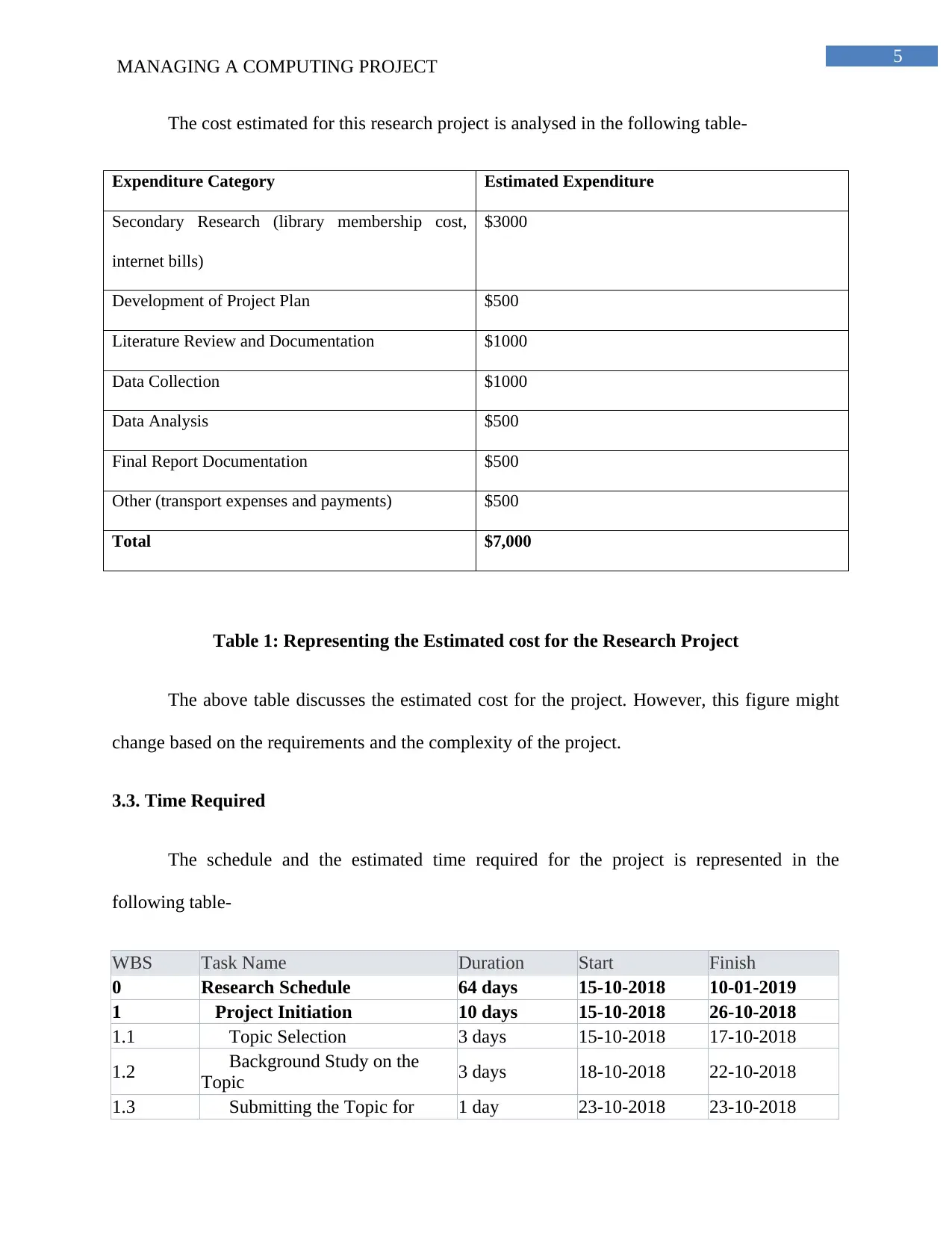
5
MANAGING A COMPUTING PROJECT
The cost estimated for this research project is analysed in the following table-
Expenditure Category Estimated Expenditure
Secondary Research (library membership cost,
internet bills)
$3000
Development of Project Plan $500
Literature Review and Documentation $1000
Data Collection $1000
Data Analysis $500
Final Report Documentation $500
Other (transport expenses and payments) $500
Total $7,000
Table 1: Representing the Estimated cost for the Research Project
The above table discusses the estimated cost for the project. However, this figure might
change based on the requirements and the complexity of the project.
3.3. Time Required
The schedule and the estimated time required for the project is represented in the
following table-
WBS Task Name Duration Start Finish
0 Research Schedule 64 days 15-10-2018 10-01-2019
1 Project Initiation 10 days 15-10-2018 26-10-2018
1.1 Topic Selection 3 days 15-10-2018 17-10-2018
1.2 Background Study on the
Topic 3 days 18-10-2018 22-10-2018
1.3 Submitting the Topic for 1 day 23-10-2018 23-10-2018
MANAGING A COMPUTING PROJECT
The cost estimated for this research project is analysed in the following table-
Expenditure Category Estimated Expenditure
Secondary Research (library membership cost,
internet bills)
$3000
Development of Project Plan $500
Literature Review and Documentation $1000
Data Collection $1000
Data Analysis $500
Final Report Documentation $500
Other (transport expenses and payments) $500
Total $7,000
Table 1: Representing the Estimated cost for the Research Project
The above table discusses the estimated cost for the project. However, this figure might
change based on the requirements and the complexity of the project.
3.3. Time Required
The schedule and the estimated time required for the project is represented in the
following table-
WBS Task Name Duration Start Finish
0 Research Schedule 64 days 15-10-2018 10-01-2019
1 Project Initiation 10 days 15-10-2018 26-10-2018
1.1 Topic Selection 3 days 15-10-2018 17-10-2018
1.2 Background Study on the
Topic 3 days 18-10-2018 22-10-2018
1.3 Submitting the Topic for 1 day 23-10-2018 23-10-2018
⊘ This is a preview!⊘
Do you want full access?
Subscribe today to unlock all pages.

Trusted by 1+ million students worldwide
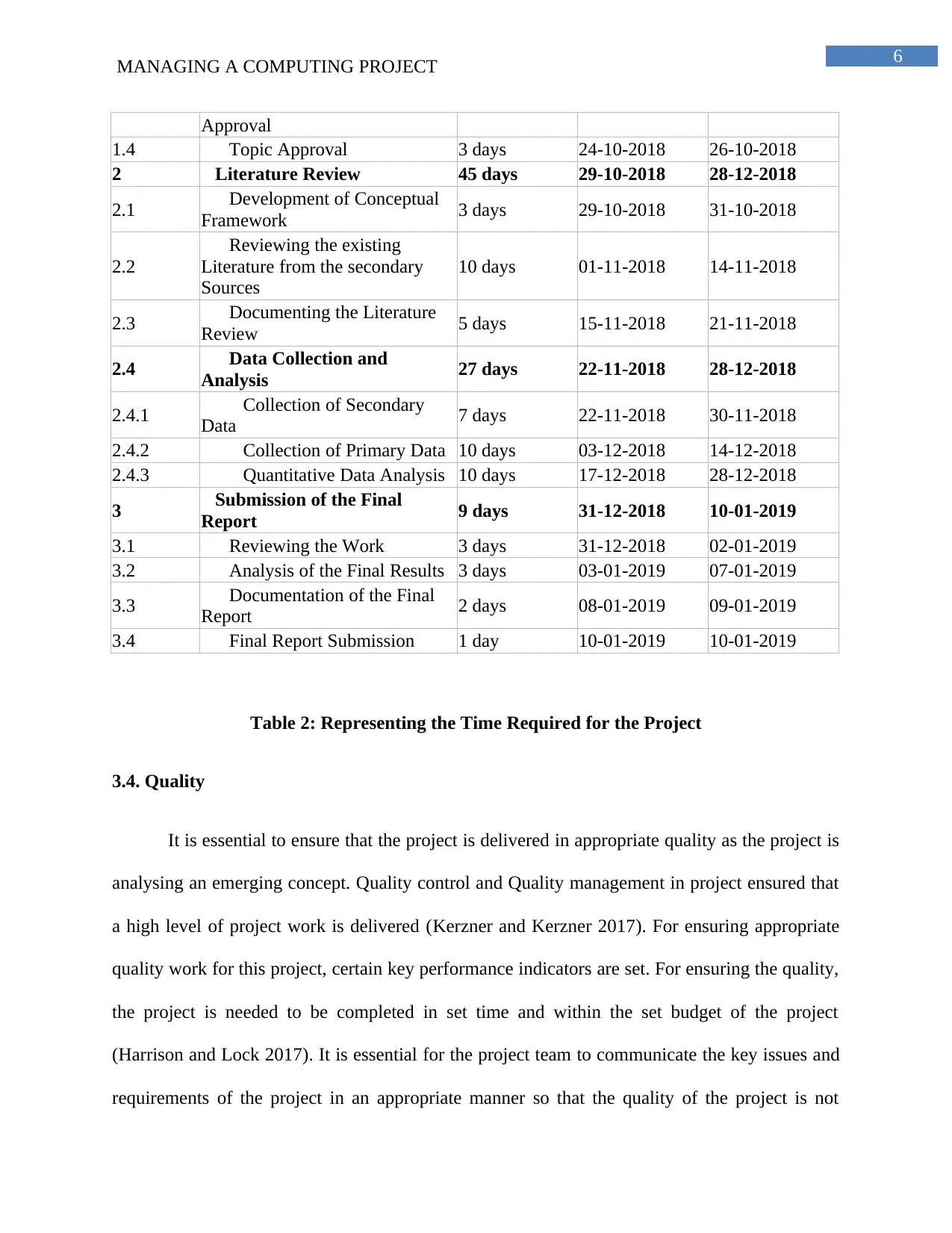
6
MANAGING A COMPUTING PROJECT
Approval
1.4 Topic Approval 3 days 24-10-2018 26-10-2018
2 Literature Review 45 days 29-10-2018 28-12-2018
2.1 Development of Conceptual
Framework 3 days 29-10-2018 31-10-2018
2.2
Reviewing the existing
Literature from the secondary
Sources
10 days 01-11-2018 14-11-2018
2.3 Documenting the Literature
Review 5 days 15-11-2018 21-11-2018
2.4 Data Collection and
Analysis 27 days 22-11-2018 28-12-2018
2.4.1 Collection of Secondary
Data 7 days 22-11-2018 30-11-2018
2.4.2 Collection of Primary Data 10 days 03-12-2018 14-12-2018
2.4.3 Quantitative Data Analysis 10 days 17-12-2018 28-12-2018
3 Submission of the Final
Report 9 days 31-12-2018 10-01-2019
3.1 Reviewing the Work 3 days 31-12-2018 02-01-2019
3.2 Analysis of the Final Results 3 days 03-01-2019 07-01-2019
3.3 Documentation of the Final
Report 2 days 08-01-2019 09-01-2019
3.4 Final Report Submission 1 day 10-01-2019 10-01-2019
Table 2: Representing the Time Required for the Project
3.4. Quality
It is essential to ensure that the project is delivered in appropriate quality as the project is
analysing an emerging concept. Quality control and Quality management in project ensured that
a high level of project work is delivered (Kerzner and Kerzner 2017). For ensuring appropriate
quality work for this project, certain key performance indicators are set. For ensuring the quality,
the project is needed to be completed in set time and within the set budget of the project
(Harrison and Lock 2017). It is essential for the project team to communicate the key issues and
requirements of the project in an appropriate manner so that the quality of the project is not
MANAGING A COMPUTING PROJECT
Approval
1.4 Topic Approval 3 days 24-10-2018 26-10-2018
2 Literature Review 45 days 29-10-2018 28-12-2018
2.1 Development of Conceptual
Framework 3 days 29-10-2018 31-10-2018
2.2
Reviewing the existing
Literature from the secondary
Sources
10 days 01-11-2018 14-11-2018
2.3 Documenting the Literature
Review 5 days 15-11-2018 21-11-2018
2.4 Data Collection and
Analysis 27 days 22-11-2018 28-12-2018
2.4.1 Collection of Secondary
Data 7 days 22-11-2018 30-11-2018
2.4.2 Collection of Primary Data 10 days 03-12-2018 14-12-2018
2.4.3 Quantitative Data Analysis 10 days 17-12-2018 28-12-2018
3 Submission of the Final
Report 9 days 31-12-2018 10-01-2019
3.1 Reviewing the Work 3 days 31-12-2018 02-01-2019
3.2 Analysis of the Final Results 3 days 03-01-2019 07-01-2019
3.3 Documentation of the Final
Report 2 days 08-01-2019 09-01-2019
3.4 Final Report Submission 1 day 10-01-2019 10-01-2019
Table 2: Representing the Time Required for the Project
3.4. Quality
It is essential to ensure that the project is delivered in appropriate quality as the project is
analysing an emerging concept. Quality control and Quality management in project ensured that
a high level of project work is delivered (Kerzner and Kerzner 2017). For ensuring appropriate
quality work for this project, certain key performance indicators are set. For ensuring the quality,
the project is needed to be completed in set time and within the set budget of the project
(Harrison and Lock 2017). It is essential for the project team to communicate the key issues and
requirements of the project in an appropriate manner so that the quality of the project is not
Paraphrase This Document
Need a fresh take? Get an instant paraphrase of this document with our AI Paraphraser
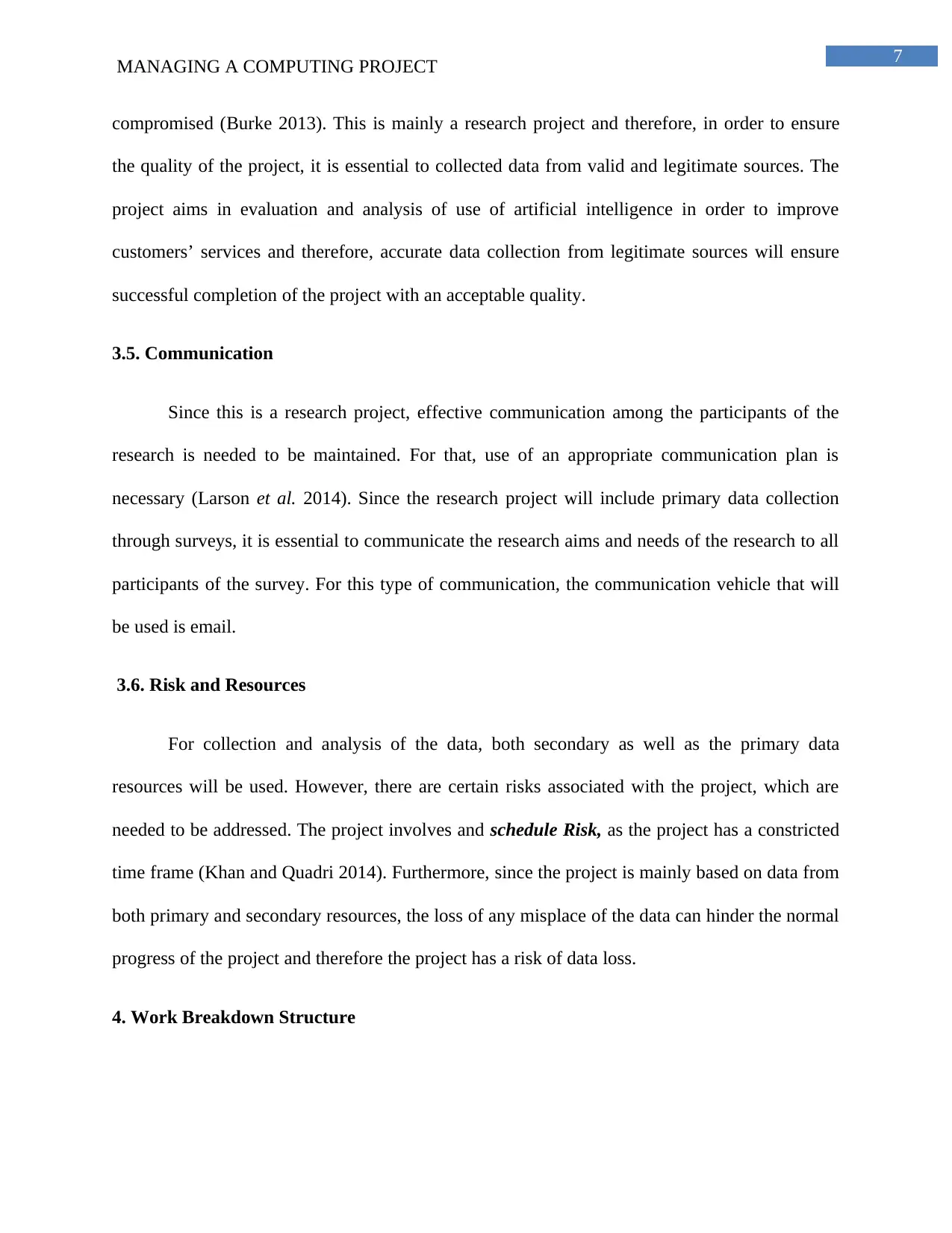
7
MANAGING A COMPUTING PROJECT
compromised (Burke 2013). This is mainly a research project and therefore, in order to ensure
the quality of the project, it is essential to collected data from valid and legitimate sources. The
project aims in evaluation and analysis of use of artificial intelligence in order to improve
customers’ services and therefore, accurate data collection from legitimate sources will ensure
successful completion of the project with an acceptable quality.
3.5. Communication
Since this is a research project, effective communication among the participants of the
research is needed to be maintained. For that, use of an appropriate communication plan is
necessary (Larson et al. 2014). Since the research project will include primary data collection
through surveys, it is essential to communicate the research aims and needs of the research to all
participants of the survey. For this type of communication, the communication vehicle that will
be used is email.
3.6. Risk and Resources
For collection and analysis of the data, both secondary as well as the primary data
resources will be used. However, there are certain risks associated with the project, which are
needed to be addressed. The project involves and schedule Risk, as the project has a constricted
time frame (Khan and Quadri 2014). Furthermore, since the project is mainly based on data from
both primary and secondary resources, the loss of any misplace of the data can hinder the normal
progress of the project and therefore the project has a risk of data loss.
4. Work Breakdown Structure
MANAGING A COMPUTING PROJECT
compromised (Burke 2013). This is mainly a research project and therefore, in order to ensure
the quality of the project, it is essential to collected data from valid and legitimate sources. The
project aims in evaluation and analysis of use of artificial intelligence in order to improve
customers’ services and therefore, accurate data collection from legitimate sources will ensure
successful completion of the project with an acceptable quality.
3.5. Communication
Since this is a research project, effective communication among the participants of the
research is needed to be maintained. For that, use of an appropriate communication plan is
necessary (Larson et al. 2014). Since the research project will include primary data collection
through surveys, it is essential to communicate the research aims and needs of the research to all
participants of the survey. For this type of communication, the communication vehicle that will
be used is email.
3.6. Risk and Resources
For collection and analysis of the data, both secondary as well as the primary data
resources will be used. However, there are certain risks associated with the project, which are
needed to be addressed. The project involves and schedule Risk, as the project has a constricted
time frame (Khan and Quadri 2014). Furthermore, since the project is mainly based on data from
both primary and secondary resources, the loss of any misplace of the data can hinder the normal
progress of the project and therefore the project has a risk of data loss.
4. Work Breakdown Structure
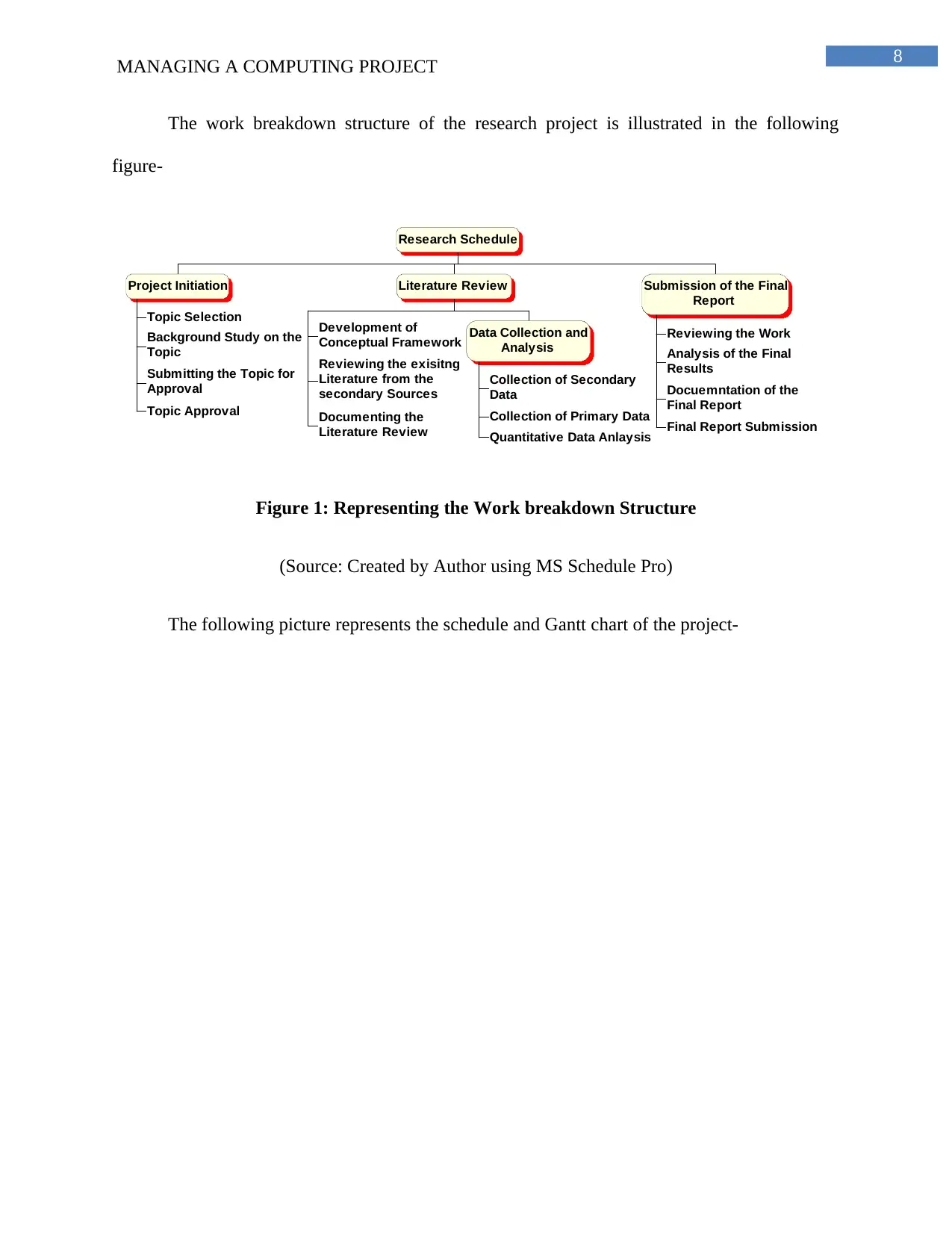
8
MANAGING A COMPUTING PROJECT
The work breakdown structure of the research project is illustrated in the following
figure-
Research Schedule
Project Initiation
Topic Selection
Background Study on the
Topic
Submitting the Topic for
Approval
Topic Approval
Literature Review
Development of
Conceptual Framework
Reviewing the exisitng
Literature from the
secondary Sources
Documenting the
Literature Review
Data Collection and
Analysis
Collection of Secondary
Data
Collection of Primary Data
Quantitative Data Anlaysis
Submission of the Final
Report
Reviewing the Work
Analysis of the Final
Results
Docuemntation of the
Final Report
Final Report Submission
Figure 1: Representing the Work breakdown Structure
(Source: Created by Author using MS Schedule Pro)
The following picture represents the schedule and Gantt chart of the project-
MANAGING A COMPUTING PROJECT
The work breakdown structure of the research project is illustrated in the following
figure-
Research Schedule
Project Initiation
Topic Selection
Background Study on the
Topic
Submitting the Topic for
Approval
Topic Approval
Literature Review
Development of
Conceptual Framework
Reviewing the exisitng
Literature from the
secondary Sources
Documenting the
Literature Review
Data Collection and
Analysis
Collection of Secondary
Data
Collection of Primary Data
Quantitative Data Anlaysis
Submission of the Final
Report
Reviewing the Work
Analysis of the Final
Results
Docuemntation of the
Final Report
Final Report Submission
Figure 1: Representing the Work breakdown Structure
(Source: Created by Author using MS Schedule Pro)
The following picture represents the schedule and Gantt chart of the project-
⊘ This is a preview!⊘
Do you want full access?
Subscribe today to unlock all pages.

Trusted by 1+ million students worldwide
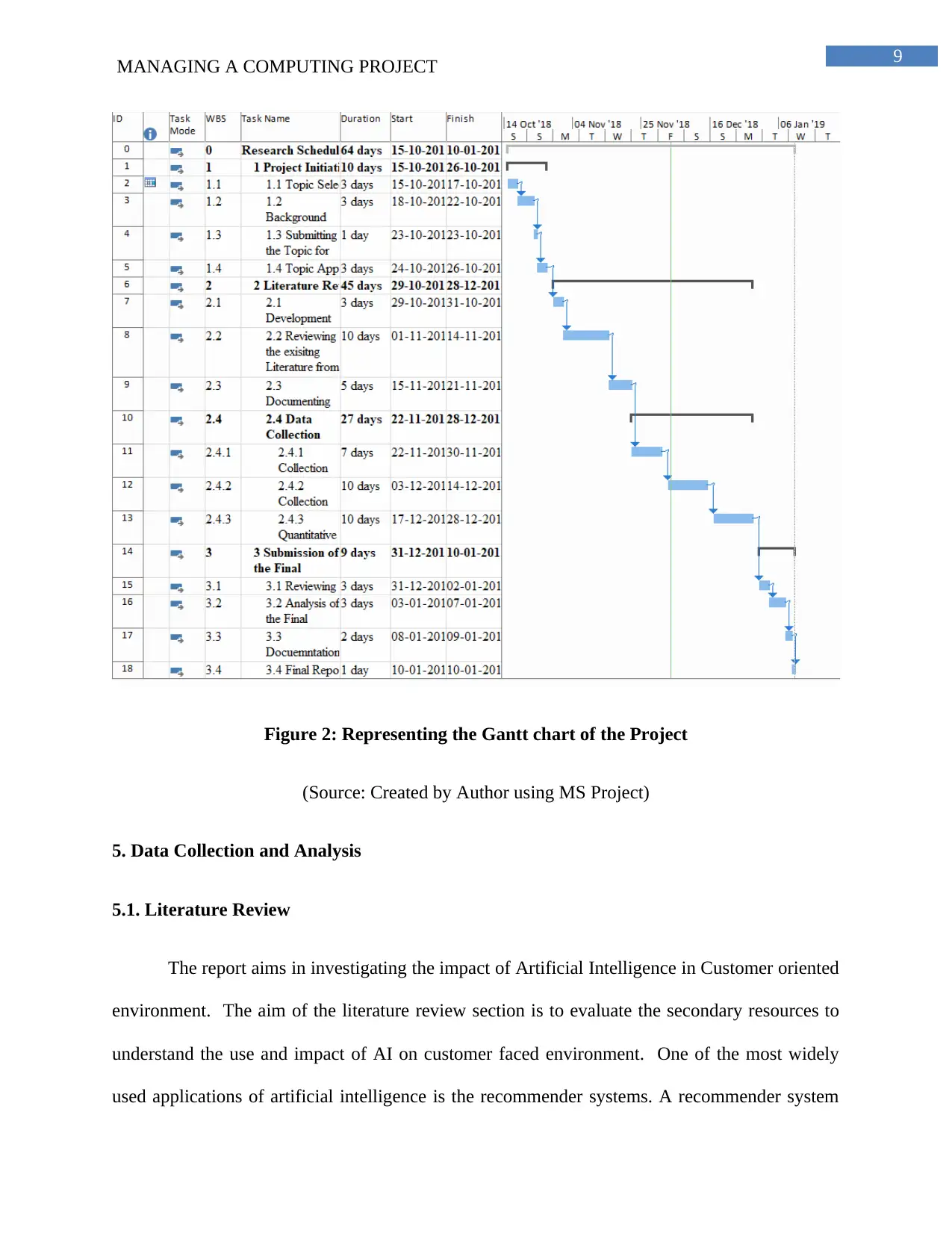
9
MANAGING A COMPUTING PROJECT
Figure 2: Representing the Gantt chart of the Project
(Source: Created by Author using MS Project)
5. Data Collection and Analysis
5.1. Literature Review
The report aims in investigating the impact of Artificial Intelligence in Customer oriented
environment. The aim of the literature review section is to evaluate the secondary resources to
understand the use and impact of AI on customer faced environment. One of the most widely
used applications of artificial intelligence is the recommender systems. A recommender system
MANAGING A COMPUTING PROJECT
Figure 2: Representing the Gantt chart of the Project
(Source: Created by Author using MS Project)
5. Data Collection and Analysis
5.1. Literature Review
The report aims in investigating the impact of Artificial Intelligence in Customer oriented
environment. The aim of the literature review section is to evaluate the secondary resources to
understand the use and impact of AI on customer faced environment. One of the most widely
used applications of artificial intelligence is the recommender systems. A recommender system
Paraphrase This Document
Need a fresh take? Get an instant paraphrase of this document with our AI Paraphraser
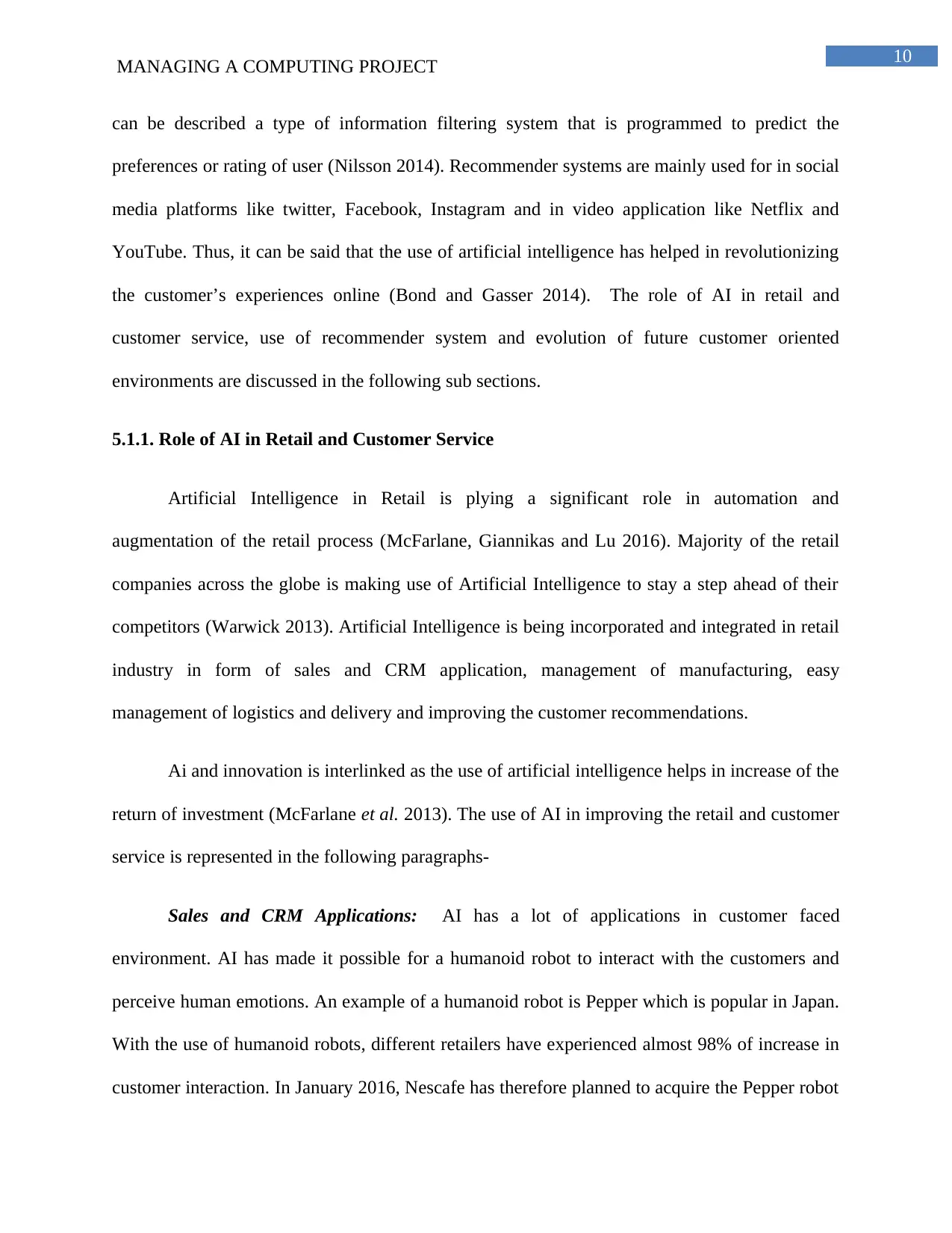
10
MANAGING A COMPUTING PROJECT
can be described a type of information filtering system that is programmed to predict the
preferences or rating of user (Nilsson 2014). Recommender systems are mainly used for in social
media platforms like twitter, Facebook, Instagram and in video application like Netflix and
YouTube. Thus, it can be said that the use of artificial intelligence has helped in revolutionizing
the customer’s experiences online (Bond and Gasser 2014). The role of AI in retail and
customer service, use of recommender system and evolution of future customer oriented
environments are discussed in the following sub sections.
5.1.1. Role of AI in Retail and Customer Service
Artificial Intelligence in Retail is plying a significant role in automation and
augmentation of the retail process (McFarlane, Giannikas and Lu 2016). Majority of the retail
companies across the globe is making use of Artificial Intelligence to stay a step ahead of their
competitors (Warwick 2013). Artificial Intelligence is being incorporated and integrated in retail
industry in form of sales and CRM application, management of manufacturing, easy
management of logistics and delivery and improving the customer recommendations.
Ai and innovation is interlinked as the use of artificial intelligence helps in increase of the
return of investment (McFarlane et al. 2013). The use of AI in improving the retail and customer
service is represented in the following paragraphs-
Sales and CRM Applications: AI has a lot of applications in customer faced
environment. AI has made it possible for a humanoid robot to interact with the customers and
perceive human emotions. An example of a humanoid robot is Pepper which is popular in Japan.
With the use of humanoid robots, different retailers have experienced almost 98% of increase in
customer interaction. In January 2016, Nescafe has therefore planned to acquire the Pepper robot
MANAGING A COMPUTING PROJECT
can be described a type of information filtering system that is programmed to predict the
preferences or rating of user (Nilsson 2014). Recommender systems are mainly used for in social
media platforms like twitter, Facebook, Instagram and in video application like Netflix and
YouTube. Thus, it can be said that the use of artificial intelligence has helped in revolutionizing
the customer’s experiences online (Bond and Gasser 2014). The role of AI in retail and
customer service, use of recommender system and evolution of future customer oriented
environments are discussed in the following sub sections.
5.1.1. Role of AI in Retail and Customer Service
Artificial Intelligence in Retail is plying a significant role in automation and
augmentation of the retail process (McFarlane, Giannikas and Lu 2016). Majority of the retail
companies across the globe is making use of Artificial Intelligence to stay a step ahead of their
competitors (Warwick 2013). Artificial Intelligence is being incorporated and integrated in retail
industry in form of sales and CRM application, management of manufacturing, easy
management of logistics and delivery and improving the customer recommendations.
Ai and innovation is interlinked as the use of artificial intelligence helps in increase of the
return of investment (McFarlane et al. 2013). The use of AI in improving the retail and customer
service is represented in the following paragraphs-
Sales and CRM Applications: AI has a lot of applications in customer faced
environment. AI has made it possible for a humanoid robot to interact with the customers and
perceive human emotions. An example of a humanoid robot is Pepper which is popular in Japan.
With the use of humanoid robots, different retailers have experienced almost 98% of increase in
customer interaction. In January 2016, Nescafe has therefore planned to acquire the Pepper robot
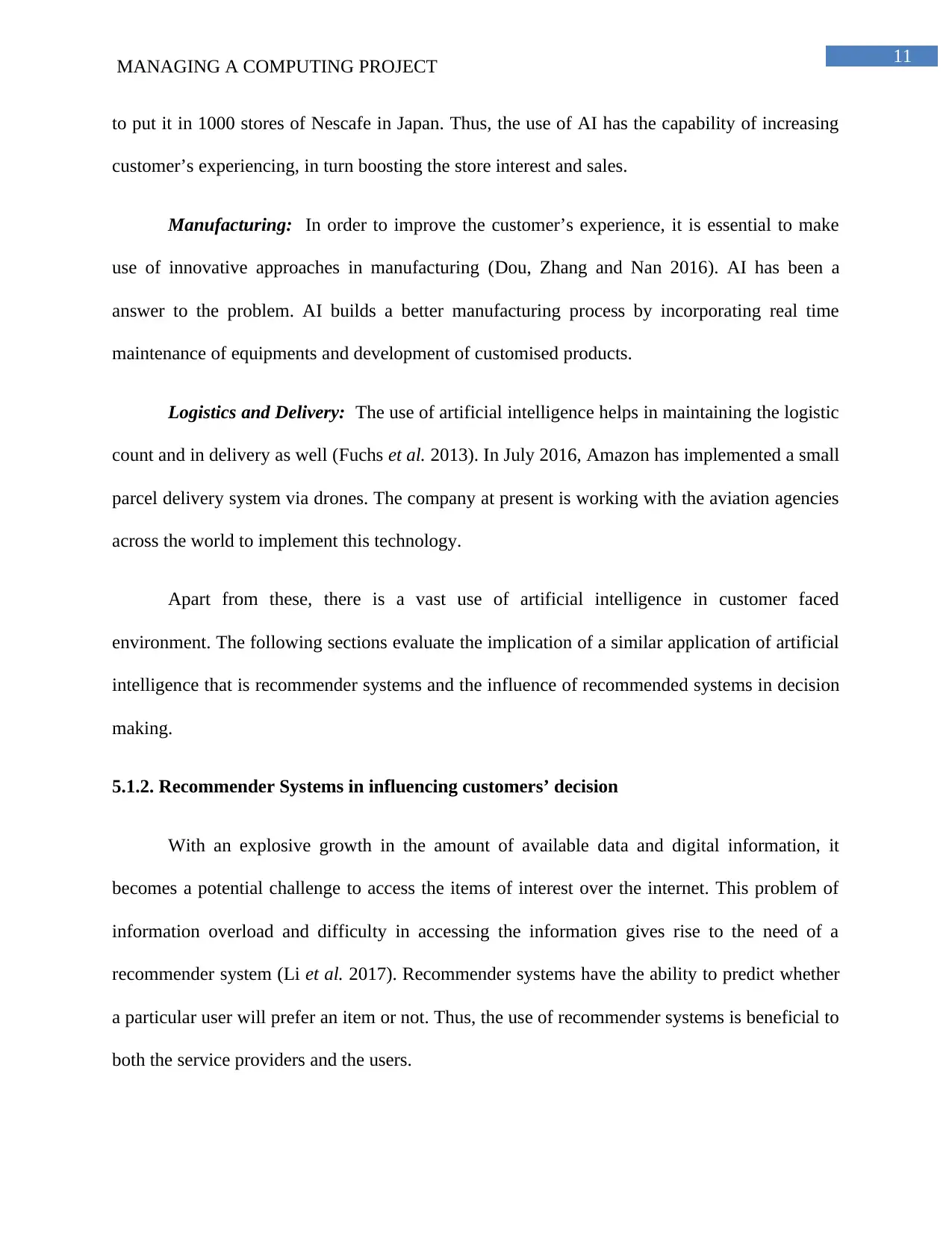
11
MANAGING A COMPUTING PROJECT
to put it in 1000 stores of Nescafe in Japan. Thus, the use of AI has the capability of increasing
customer’s experiencing, in turn boosting the store interest and sales.
Manufacturing: In order to improve the customer’s experience, it is essential to make
use of innovative approaches in manufacturing (Dou, Zhang and Nan 2016). AI has been a
answer to the problem. AI builds a better manufacturing process by incorporating real time
maintenance of equipments and development of customised products.
Logistics and Delivery: The use of artificial intelligence helps in maintaining the logistic
count and in delivery as well (Fuchs et al. 2013). In July 2016, Amazon has implemented a small
parcel delivery system via drones. The company at present is working with the aviation agencies
across the world to implement this technology.
Apart from these, there is a vast use of artificial intelligence in customer faced
environment. The following sections evaluate the implication of a similar application of artificial
intelligence that is recommender systems and the influence of recommended systems in decision
making.
5.1.2. Recommender Systems in influencing customers’ decision
With an explosive growth in the amount of available data and digital information, it
becomes a potential challenge to access the items of interest over the internet. This problem of
information overload and difficulty in accessing the information gives rise to the need of a
recommender system (Li et al. 2017). Recommender systems have the ability to predict whether
a particular user will prefer an item or not. Thus, the use of recommender systems is beneficial to
both the service providers and the users.
MANAGING A COMPUTING PROJECT
to put it in 1000 stores of Nescafe in Japan. Thus, the use of AI has the capability of increasing
customer’s experiencing, in turn boosting the store interest and sales.
Manufacturing: In order to improve the customer’s experience, it is essential to make
use of innovative approaches in manufacturing (Dou, Zhang and Nan 2016). AI has been a
answer to the problem. AI builds a better manufacturing process by incorporating real time
maintenance of equipments and development of customised products.
Logistics and Delivery: The use of artificial intelligence helps in maintaining the logistic
count and in delivery as well (Fuchs et al. 2013). In July 2016, Amazon has implemented a small
parcel delivery system via drones. The company at present is working with the aviation agencies
across the world to implement this technology.
Apart from these, there is a vast use of artificial intelligence in customer faced
environment. The following sections evaluate the implication of a similar application of artificial
intelligence that is recommender systems and the influence of recommended systems in decision
making.
5.1.2. Recommender Systems in influencing customers’ decision
With an explosive growth in the amount of available data and digital information, it
becomes a potential challenge to access the items of interest over the internet. This problem of
information overload and difficulty in accessing the information gives rise to the need of a
recommender system (Li et al. 2017). Recommender systems have the ability to predict whether
a particular user will prefer an item or not. Thus, the use of recommender systems is beneficial to
both the service providers and the users.
⊘ This is a preview!⊘
Do you want full access?
Subscribe today to unlock all pages.

Trusted by 1+ million students worldwide
1 out of 24
Related Documents
Your All-in-One AI-Powered Toolkit for Academic Success.
+13062052269
info@desklib.com
Available 24*7 on WhatsApp / Email
![[object Object]](/_next/static/media/star-bottom.7253800d.svg)
Unlock your academic potential
Copyright © 2020–2025 A2Z Services. All Rights Reserved. Developed and managed by ZUCOL.


